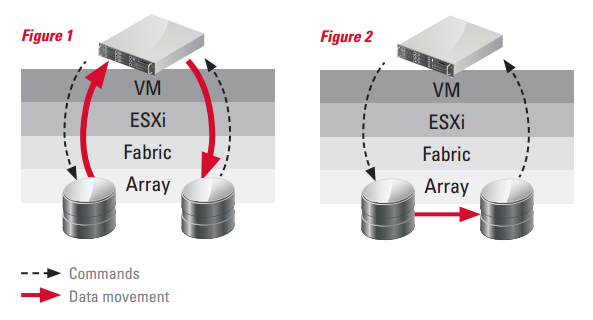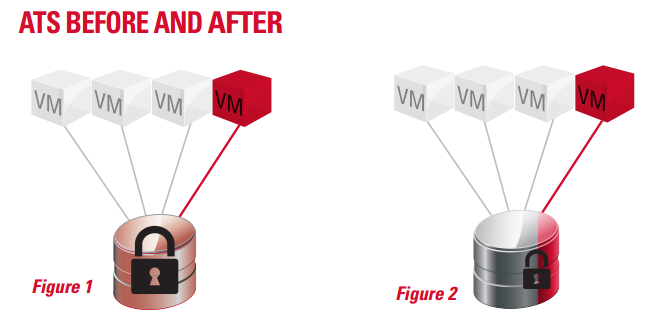
Increased VMware Performance on Nexsan Storage
Unlock performance and efficiencies through Nexsan's implementation of VMware VAAI
With all of the advantages of virtualizing IT resources using VMware, storage operations have been an area of focus for performance improvements. Nexsan’s integration of VMware vSphere 5 Storage APIs for Array Integration (VAAI) bring storage management into the same level of efficiency, automation, and performance as other VMware operations.
Discover how storage administrators and IT management alike will see immediate benefits in the combination of Nexsan block storage and VAAI to –
- Increase IT flexibility and efficiency
- Improve usage of both server and storage resources
- Add business agility, with administrators freed to focus more on the business and less on VMware maintenance
Speeding up SANs
The principal resource management issue for storage in a vSphere environment is related to how data moves. Until recently, common administrative operations meant relying on relatively slow-performing software-based data movement. Having VMkernel DataMover issue I/O commands to read and write blocks in both the source and target datastores consumes massive system resources on the vSphere server, including CPU cycles on host servers and SCSI commands in the HBA queue. (Figure 1)
Using VAAI with Nexsan block storage systems, vSphere simply issues the command to the array, which completes it without creating a performance bottleneck at the host level. The I/O-hungry work of cloning, migrating virtual machines, and creating zero blocks is now hardware-accelerated within the Nexsan array itself, with many storage operations seeing dramatically improved performance. (Figure 2)
Utilize Nexsan’s combined implementation of VAAI for common administrative tasks and FASTier caching technology to accelerate operational performance. FASTier cache, available on NST5000TM systems, delivers high random I/O throughput, supporting VMware servers to maximum effect.

Performance Improvements on Nexsan Block Systems
VAAI comprises three APIs, or “primitives,” that are activated by default on NST-family and E-Series systems.
Atomic Test and Set (ATS) improves performance and manageability when performing operations on VMs requiring locking.
- Before ATS, when making a state change to a VM, VMware ESXi would lock the entire storage pool – and all of the resident VMs – using a SCSI reservation prior to the operation. (Figure 1)
- With ATS, locking granularity is greatly improved. The vSphere host now locks only the blocks on which the VMs being cloned or moved reside, allowing access to other VMs on the LUN by multiple hosts. (Figure 2)

Administrators may utilize the benefits of ATS to increase their consolidation ratio, knowing that they can keep multiple VMs available to multiple hosts even during administrative operations.
Hardware Accelerated Copy (HAC) offers dramatic performance improvements for cloning and migration of VMs.
- Before HAC, these common storage-intensive tasks were completed by sending intensive I/O through the vSphere host server. The required bandwidth would often significantly challenge the host’s performance resources, and delay the performance of other tasks.
- With HAC, the vSphere host offloads these I/O operations by leveraging the native Nexsan array EXTENDED COPY SCSI (or XCOPY) command. Once the vSphere host issues a copy or migrate command through vMotion, the operation is completed between the source and target LUNs or arrays. This offers significant performance improvements, while freeing up CPU, memory, fabric, and other host resources.
Block Zero offers similar efficiencies for creating new virtual machine disks (VMDKs).
- Before Block Zero, writing zero blocks for fault-tolerant VMs, or those for Microsoft Cluster Service, was a time- and resource-intensive process. Each command for zeroing a block would run from the vSphere host, to the array, and back to the host for acknowledgement.
- With Block Zero, these redundant host-based I/O write commands are replaced by optimized commands executed in the Nexsan array. The host issues a single command, and the array completes the WRITE SAME SCSI operations within the storage infrastructure. Again, this frees up the vSphere host’s resources for other tasks, and reduces the time-to-completion for zeroing operations.
Proactive Management Capabilities
Nexsan has also integrated a key feature of VAAI that delivers additional management capabilities for block storage using NST storage systems. Thin Provisioning Unmap enables higher availability for VMs and improved storage management for a thin-provisioned environment.
- Before Unmap, understanding when a thin-provisioned volume was reaching maximum capacity was a manual process. Once the volume ran out of capacity, likely results would include VMs crashing and data being corrupted. This could result in real business impacts; for example, if the affected VMs included an e-commerce database where orders were being lost while the volume was out of space. Additionally, when capacity was freed up by migrating or deleting a VM, the vSphere host had no mechanism to notify the array that the blocks were now free.
- With Unmap, the administrator sets a capacity threshold in NST OS for thin-provisioned volumes. When capacity exceeds the threshold, the array issues a notification to vCenter. This gives the administrator flexibility to manage the array proactively by adding capacity, issuing a vMotion command to delete or move VMs, or extending the datastore. This keeps critical VMs operating without surprises from a storage standpoint. Unmap also includes a simple command that allows reclamation of space once a VM has been migrated or deleted, further enabling proactive management of the array.
Storage Optimized for VMware Performance
Combine these capabilities with Nexsan performance, manageability, and reliability that scales to petabytes in a small rack footprint. Utilize FASTierTM caching in NST-series products to meet the random I/O performance requirements of a VMware environment, accelerating storage performance to solid-state levels at the price of HDD-based systems. Nexsan E-Series products offer extreme density with up to 15 drives/U, delivering high reliability with no single point of failure while providing an ideal platform for efficiently managing the growth of VMware environments.

